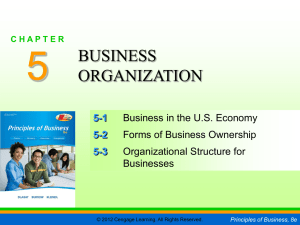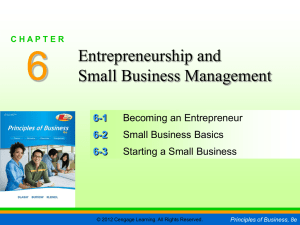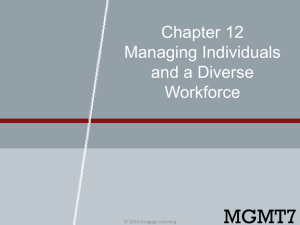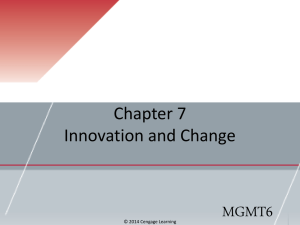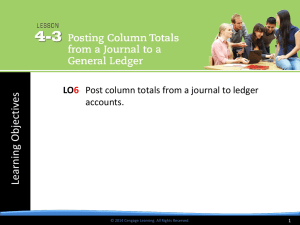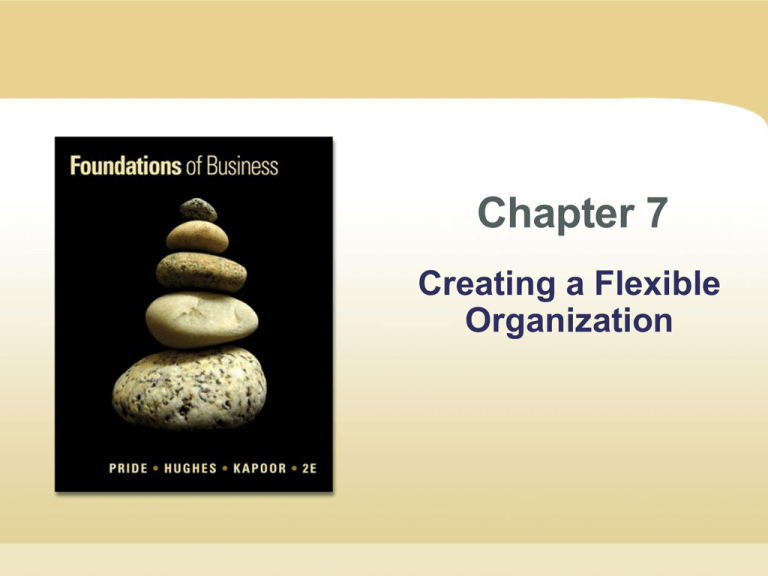
Chapter 7
Creating a Flexible
Organization
Learning Objectives
1. Understand what an organization is and identify its
characteristics.
2. Explain why job specialization is important.
3. Identify the various bases for departmentalization.
4. Explain how decentralization follows from delegation.
5. Understand how the span of management describes an
organization.
6. Understand how the chain of command is established by
using line and staff management.
7. Describe the four basic forms of organizational structure:
bureaucratic, matrix, cluster, and network.
8. Summarize the use of corporate culture, intrapreneurship,
committees, coordination techniques, informal groups, and
the grapevine.
Copyright © Cengage Learning. All rights reserved.
Chapter 7 | Slide 2
Organization
…a group of two or more people
working together to achieve a
common set of goals.
Copyright © Cengage Learning. All rights reserved.
Chapter 7 | Slide 3
Organization Chart
…a diagram that represents the
positions and relationships within
an organization.
Copyright © Cengage Learning. All rights reserved.
Chapter 7 | Slide 4
Figure 7.1: A Typical Organization Chart
A company’s organization chart represents the positions
and relationships within the organization and shows the
managerial chains of command.
Copyright © Cengage Learning. All rights reserved.
Chapter 7 | Slide 5
Chain of Command
…the line of authority that extends
from the highest to the lowest levels
of an organization.
Copyright © Cengage Learning. All rights reserved.
Chapter 7 | Slide 6
Reasons to Not
Maintain Organizational Chart
Difficult to chart positions
Constant change
Copyright © Cengage Learning. All rights reserved.
Chapter 7 | Slide 7
5 Steps for
Organizing a Business
1. Job Design
2. Departmentalization
3. Delegation
4. Span of Management
5. Chain of Command
Copyright © Cengage Learning. All rights reserved.
Chapter 7 | Slide 8
Job Specialization
…the separation of all organizational
activities into distinct tasks and the
assignment of different tasks to
different people.
Copyright © Cengage Learning. All rights reserved.
Chapter 7 | Slide 9
Rationale for Specialization
Job too large for one person
More efficient
No lost time changing between operations
More-specialized job makes it easier to design
specialized equipment
More specialized the job the easier the job
training
Copyright © Cengage Learning. All rights reserved.
Chapter 7 | Slide 10
Combating Job
Specialization Boredom
Job rotation
Job enlargement
Job enrichment
Copyright © Cengage Learning. All rights reserved.
Chapter 7 | Slide 11
Departmentalization
…process of grouping jobs into
manageable units.
Copyright © Cengage Learning. All rights reserved.
Chapter 7 | Slide 12
Bases for Departmentalization
Function
Product
Location
Customer
Copyright © Cengage Learning. All rights reserved.
Chapter 7 | Slide 13
Function
…grouping jobs that relate to the
same organizational activity.
Copyright © Cengage Learning. All rights reserved.
Chapter 7 | Slide 14
Product
…grouping activities related to
a particular product or service.
Copyright © Cengage Learning. All rights reserved.
Chapter 7 | Slide 15
Location
…grouping activities according
to the defined geographic area in
which they are performed.
Copyright © Cengage Learning. All rights reserved.
Chapter 7 | Slide 16
Customer
…grouping activities according to the
needs of various customer populations.
Copyright © Cengage Learning. All rights reserved.
Chapter 7 | Slide 17
Figure 7.2: Multibase Departmentalization for
New-Wave Fashions, Inc.
Most firms use more than one basis for departmentalization to
improve efficiency and to avoid overlapping positions.
Copyright © Cengage Learning. All rights reserved.
Chapter 7 | Slide 18
Delegation
…assigning part of a manager’s work
and power to other workers.
Copyright © Cengage Learning. All rights reserved.
Chapter 7 | Slide 19
Figure 7.3: Steps in the Delegation Process
To be successful, a
manager must learn
how to delegate.
No one can do
everything alone.
Copyright © Cengage Learning. All rights reserved.
Chapter 7 | Slide 20
Responsibility
…the duty to do a job or perform a task.
Copyright © Cengage Learning. All rights reserved.
Chapter 7 | Slide 21
Authority
…the power, within an organization, to
accomplish an assigned job or task.
Copyright © Cengage Learning. All rights reserved.
Chapter 7 | Slide 22
Accountability
…the obligation of a worker to
accomplish an assigned job or task.
Copyright © Cengage Learning. All rights reserved.
Chapter 7 | Slide 23
Barriers to Delegation
Desire to ensure that
the job
gets done
Fear that worker will
do well and attract
notice of higher-level
managers
Inability to plan and
assign work effectively
Copyright © Cengage Learning. All rights reserved.
Chapter 7 | Slide 24
Decentralized Organization
…an organization in which
management consciously attempts to
spread authority widely in the lower
levels.
Copyright © Cengage Learning. All rights reserved.
Chapter 7 | Slide 25
Centralized Organization
…an organization that systematically
works to concentrate authority at the
upper levels.
Copyright © Cengage Learning. All rights reserved.
Chapter 7 | Slide 26
Factors Influencing Decentralization
Complexity/predictability of external environment
Risk/importance of decision
Abilities of lower-level managers
Past practice
Copyright © Cengage Learning. All rights reserved.
Chapter 7 | Slide 27
Span of Management
…the number of workers who report
directly to one manager.
Wide vs. Narrow
Flat vs. Tall
Copyright © Cengage Learning. All rights reserved.
Chapter 7 | Slide 28
Figure 7.4: The Span of Management
Copyright © Cengage Learning. All rights reserved.
Chapter 7 | Slide 29
Organizational Height
…the number of layers, or levels,
of management in a firm.
Copyright © Cengage Learning. All rights reserved.
Chapter 7 | Slide 30
Tall Organizations
Administrative costs high because of layers
of management
Communication among levels distorted
Copyright © Cengage Learning. All rights reserved.
Chapter 7 | Slide 31
Wide Organizations
Managers perform more administrative duties
Managers spend more time supervising and
working with subordinates
Copyright © Cengage Learning. All rights reserved.
Chapter 7 | Slide 32
Line Management Position
…a position that is part of the chain
of command and that includes direct
responsibility for achieving the goals
of the organization.
Copyright © Cengage Learning. All rights reserved.
Chapter 7 | Slide 33
Staff Management Position
…a position created to provide
support, advice, and expertise
within an organization.
Copyright © Cengage Learning. All rights reserved.
Chapter 7 | Slide 34
Line vs. Staff
Line managers = line/direct authority
Staff managers
• Advisory authority
• Functional authority
Conflicts
• To line from staff
o More formal education
o Younger
• To staff from line ─ ignored
Copyright © Cengage Learning. All rights reserved.
Chapter 7 | Slide 35
Figure 7.5: Line and Staff Management
Copyright © Cengage Learning. All rights reserved.
Chapter 7 | Slide 36
Table 7.1: Five Characteristics of
Organizational Structure
Copyright © Cengage Learning. All rights reserved.
Chapter 7 | Slide 37
Bureaucratic Structure
…a management system based on a formal
framework of authority that is outlined
carefully and followed precisely.
Copyright © Cengage Learning. All rights reserved.
Chapter 7 | Slide 38
Characteristics of a Bureaucracy
Departmentalization by function
Formal patterns of delegation
High degree of centralization
Narrow span of management = tall organization
Clearly defined line/staff positions with formal
relationships between the two
Copyright © Cengage Learning. All rights reserved.
Chapter 7 | Slide 39
Matrix Structure
…an organizational structure that combines
vertical and horizontal lines of authority,
usually by superimposing product
departmentalization on a functionally
departmentalized organization.
Copyright © Cengage Learning. All rights reserved.
Chapter 7 | Slide 40
Cross-Functional Team
…a group of employees from different
departments who work together on a
specific project.
Copyright © Cengage Learning. All rights reserved.
Chapter 7 | Slide 41
Figure 7.6: A Matrix Structure
Copyright © Cengage Learning. All rights reserved.
Chapter 7 | Slide 42
Advantages of Matrix Structure
Flexibility
Increased productivity
Raises morale
Nurtures creativity
and innovation
Employees experience
personal development
Copyright © Cengage Learning. All rights reserved.
Chapter 7 | Slide 43
Disadvantages of Matrix Structure
Reporting to 1+ supervisor = confusion
Longer to resolve problems
Personality clashes
Poor communication
Undefined individual roles
Unclear responsibilities
Ways to reward individual/team performance
Expense to maintain
Copyright © Cengage Learning. All rights reserved.
Chapter 7 | Slide 44
Cluster Structure
…an organization that consists
primarily of teams with no or very few
underlying departments.
Copyright © Cengage Learning. All rights reserved.
Chapter 7 | Slide 45
Team or Collaborative Organization
Team members work together on a project
until finished
Team may remain intact when assigned
another project
Or
Team members may be reassigned to
different teams
Copyright © Cengage Learning. All rights reserved.
Chapter 7 | Slide 46
Cluster Structure
Strengths
Flexibility
Try new techniques
Explore new ideas
Copyright © Cengage Learning. All rights reserved.
Weaknesses
Lack of job security
Increased stress
Rapid changes
Chapter 7 | Slide 47
Network Structure
…an organization in which administration is
the primary function, and most other
functions are contracted out to other firms.
Copyright © Cengage Learning. All rights reserved.
Chapter 7 | Slide 48
Network Structure
No manufacturing of product it sells
Few permanent employees
• Top management
• Hourly clerical
Leased facilities/equipment
Temporary workers
Limited formal structure
Copyright © Cengage Learning. All rights reserved.
Chapter 7 | Slide 49
Strengths/Challenges of Network Structure
Strength = flexibility
Challenges
• Quality control
• Low morale/high turnover
• Vulnerability to outside contractors
Copyright © Cengage Learning. All rights reserved.
Chapter 7 | Slide 50
Corporate Culture
…the inner rites, rituals, heroes,
and values of a firm.
Copyright © Cengage Learning. All rights reserved.
Chapter 7 | Slide 51
Corporate Culture Indicators
Physical setting
What company says about culture
How guests greeted
How employees spend their time
Copyright © Cengage Learning. All rights reserved.
Chapter 7 | Slide 52
Figure 7.7: Types of
Corporate Cultures
Copyright © Cengage Learning. All rights reserved.
Chapter 7 | Slide 53
Organizations of the Future
Small, task-oriented
work groups
Control over own
activities
Computer coordinated
Strong corporate culture
Supports trust and risk
taking
Copyright © Cengage Learning. All rights reserved.
Chapter 7 | Slide 54
Intrapreneur
…an employee who pushes an
innovative idea, product, or process
through an organization.
Copyright © Cengage Learning. All rights reserved.
Chapter 7 | Slide 55
Committees
Ad Hoc ─ created for a specific
short-term purpose
Standing ─ permanent and charged with
performing some recurring task
Task Force ─ created to investigate a major
problem/pending decision
Copyright © Cengage Learning. All rights reserved.
Chapter 7 | Slide 56
Coordination Techniques
Managerial Hierarchy ─ provides increased
authority at higher levels of management
Informal Organization ─ stems from personal
rather than official relationships
• Informal group
• Grapevine
Copyright © Cengage Learning. All rights reserved.
Chapter 7 | Slide 57
Chapter Quiz
1. Solid vertical lines on an organization chart indicate
relationships among
a)
b)
c)
d)
e)
staff positions.
employees.
delegated positions.
the chain of command.
line and staff positions.
Copyright © Cengage Learning. All rights reserved.
Chapter 7 | Slide 58
Chapter Quiz (cont.)
2. The systematic shifting of employees from one job to another is
called job
a)
b)
c)
d)
e)
specialization.
rotation.
sharing.
enlargement.
enrichment.
Copyright © Cengage Learning. All rights reserved.
Chapter 7 | Slide 59
Chapter Quiz (cont.)
3. Grouping all activities according to the geographic area in
which they are located is departmentalization by
a)
b)
c)
d)
e)
function.
employee.
product.
customer.
location.
Copyright © Cengage Learning. All rights reserved.
Chapter 7 | Slide 60
Chapter Quiz (cont.)
4. In a __________ organization, administrative costs are higher
because more managers are needed.
a)
b)
c)
d)
e)
long
flat
tall
short
broad
Copyright © Cengage Learning. All rights reserved.
Chapter 7 | Slide 61
Chapter Quiz (cont.)
5. The power to accomplish an assigned job is called
a)
b)
c)
d)
e)
authority.
accountability.
responsibility.
delegation.
obligation.
Copyright © Cengage Learning. All rights reserved.
Chapter 7 | Slide 62


